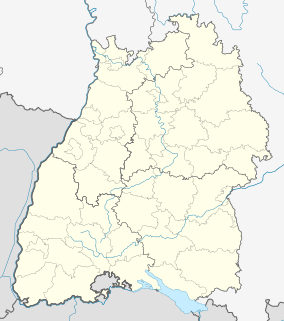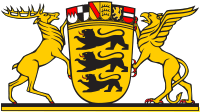Castle Solitude
| Castle Solitude | |
|---|---|
| Schloss Solitude | |
|
Baden-Württemberg's Coat of Arms | |
 Castle Solitude | |
 Castle Solitude Location in Baden-Württemberg | |
| Etymology | Solitude (French: Loneliness), the lonely Schloss |
| General information | |
| Status | Complete |
| Type | Schloss |
| Architectural style | Neoclassic[1] |
| Classification | Palace |
| Location | Baden-Württemberg |
| Address | Solitude 1, 70197 Stuttgart, Germany |
| Town or city | Weilimdorf |
| Country | Germany |
| Coordinates | 48°47′13″N 9°5′3″E / 48.78694°N 9.08417°ECoordinates: 48°47′13″N 9°5′3″E / 48.78694°N 9.08417°E |
| Groundbreaking | 1763 |
| Construction started | 1764 |
| Completed | 1767 |
| Opened | 1769 |
| Renovated | 1972 - 1983 |
| Client | Charles Eugene, Duke of Württemberg |
| Design and construction | |
| Architect |
Johann Friedrich Weyhing |
| Known for | Housing the Karlsschule, Friederich Schiller |
| Website | |
|
www | |
Castle Solitude (English: Loneliness) is a Rococo Schloss (German: palace) (thus not a true castle) and hunting retreat commissioned by Duke Charles Eugene, designed by Johann Friedrich Weyhing and Philippe de La Guêpière, and constructed from 1764-69. Since 1956 the area is part of the urban district of Stuttgart-West despite the castle being located just southeast of the town of Gerlingen. Solitude is located on an elongated ridge between the towns of Leonberg, Gerlingen and Stuttgart. The castle offers views to the north over the towns of Weilimdorf, Korntal and Ludwigsburg and the Württemberg lowlands around Ludwigsburg.[1]
On April 1, 1942, Schloss Solitude was incorporated into Stuttgart. Since 1956, Schloss Solitude has been part of Stuttgart-West.
History
The construction period was characterized by political and financial adversity. The Schloss was commissioned Duke Charles Eugene as a refugium, a place of quiet reflection and solitude (he had recently made the questionable decision to take Württemberg into the Seven Years' War on the losing side against Prussia).[3] The Duke hired a commission of architects led by Philippe de La Guêpière and planning began in 1763.[1] Problems arose, however: money from the Duke was running low (construction costs were already exceeding what the Duchy had allocated), and construction stalled.[4] Further political struggles between the Duke and influential Stuttgart land barons led to the Duke temporarily abandoning Stuttgart in favor of the palace in Ludwigsburg. The Duke shifted his attention to Hohenheim in 1775. In the long run, the castle was prohibitively expensive to keep just as a temporary residence.
A high school was founded inside the palace in 1770 and the Karlsschule (German: Karl's high school) established a school and orphanage for studying military practice and the arts in Castle Solitude (Later, it would become a university where children of the elite could study military practice and the arts)[5] High maintenance costs led to the closure of the school following the Duke's death in the late 18th century.
Solitude was abandoned in the 20th Century, the gardens fell into disrepair, and the ceiling frescoes by Nicolas Guibal were largely destroyed by water damage. Between 1972 and 1983, the Federal Republic of Germany renovated the castle and the frescoes were restored.[1] From May 1968 to 1986, was located in today's academy building an autonomous dorm. Many of the residents were musicians, actors and dancers, were added social workers, architects and engineers. They got together and organized concerts, jazz sessions, dance theater and other art projects. Professor K.R.H. Sonderborg from the Stuttgart Art Academy, the conductor Manfred Schreier and the actress Bettina copper were frequent guests.
Current use
Since 1990, the annexed buildings (Officen and Kavaliers-buildings) have housed the Akademie Schloss Solitude. The Kavaliers building incorporates living quarters for students.
Here too is Graevenitz Museum housed. It displays works by the Stuttgart sculptor Fritz von Graevenitz (1892-1959)
Race track
After 1903, Castle Solitude was the finishing point of hill races. In later years, the grounds of the castle served as a hostel for drivers. From 1935 to 1965, the 11.3-kilometre (7.0 mi) Solituderennen course south of the castle was used for World Championship motorcycle Grand Prix racing. From 1961 to 1965, a series of non-championship Formula 1 races were also held on the same weekends, welcoming drivers such as John Surtees, Jim Clark, Dan Gurney and Jack Brabham. In their heyday, the Solitude races attracted crowds of 288,000 spectators, but they were discontinued in 1966.
Architecture
Castle Solitude was designed by a working group at the ducal court under the guidance of Philippe de La Guêpière with active input from Duke Karl Eugen and master craftsmen. Its exterior is typical Rococo. On the inside, however, the style is characteristic of classicism: instead of the irregular lively forms typical of Rococo, the proportions of the rooms and wall are typically classical in design.

Solitude avenue
The northern main gate of the castle marks the beginning of Solitudeallee, a partially tree-lined straight avenue leads directly to Ludwigsburg over 13 kilometres (8 mi). Duke Karl-Eugen commissioned the building of the avenue from 1764 to 1768 as a connecting route to the residence palace in Ludwigsburg. The avenue, which is still largely intact today, leads via Stuttgart-Weilimdorf past Stuttgart-Zuffenhausen and Stuttgart-Stammheim. Only in Weilimdorf, where it intersects the main street, and in Ludwigsburg, where it is interrupted by the railway, are there minor irregularities. According to a plaque inside the castle, the avenue served as the baseline for the Württemberg land survey of 1820 and measures exactly 40,118.718 Paris feet or 13,032.14 metres (42,756.4 ft).
In 2003, a revival competition was staged in and around the castle with former competitors and ex-world champions such as Giacomo Agostini. A rally to commemorate the 50th anniversary of races was held in 2004.
Suburb
The area of Castle Solitude first belonged to Weilimdorf. After the middle of the 19th century it belonged to Gerlingen until the 31st of March 1942, at which point it was assigned to the suburb of Botnang before being integrated into the district of Stuttgart-West in 1956.
Trivia
- The most notable alumni to attend the Karlsschule at Solitude was Friedrich Schiller. It was here that a young Schiller turned his life around and discovered Poetry.[6]
- Schiller's father, Johann Caspar Schiller, was also enrolled at the Karlsschule. He served as the Head Gardner of the Ducal palace.[Note 1]
See also
Notes
- ↑ See this letter from Johann to Friedrich: "Dearest son...in addition to that, I am currently writing to inquire about your well being and give you news of our former Director, Mr. Cammer [Johann Christoph] Dertinger; next time, come to Mannheim and there ask for him. He is one of my best friends, and I have known him for 33 friendship-filled years. [d. i. Duke Charles II. Eugen of Württemberg] proposed to my local field."[7]
Citations
Bibliography
- Eyewitness Travel Guide to Germany. 95 Madison Avenue, New York, NY: Dorling Kindersley Publishing. August 6, 2001. ISBN 0-7894-6646-5.
- Zimdars, Dagmar (1993). Georg Dehio: Handbuch der Deutschen Kunstdenkmäler. Baden-Württemberg I. Berlin and Munich: Deutscher Kunstverlag. ISBN 3-422-03024-7.
- Schwarz, Jürgen (2004). Schiller kennen lernen. Lichtenau.
- Schubert-Felmy, Barbara (1999). Die Räuber und andere Räubergeschichten. Schöningh. ISBN 3-506-22284-8.
- Kurscheidt, Georg (1989). Schillers Werke. Nationalausgabe. 33. Weimar. pp. 100 et seq. ISBN 3-7400-0074-0.
External links
- "Solitude Palace" at Stattliche Schlösser und Gärten Baden Württemberg
- (German) Memorial site of the Solitude races

